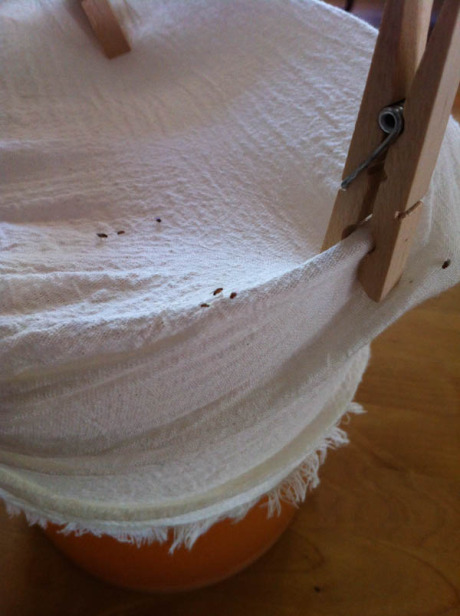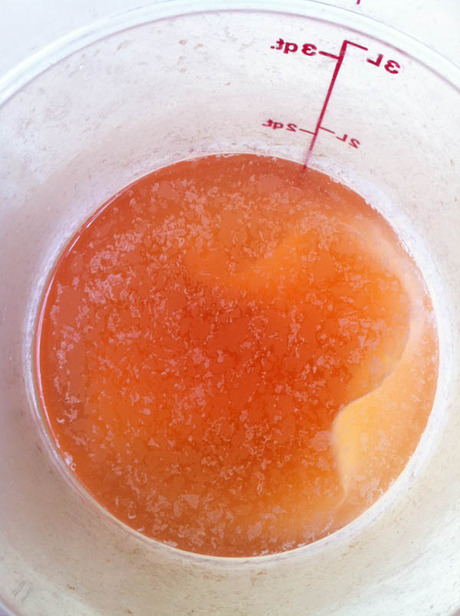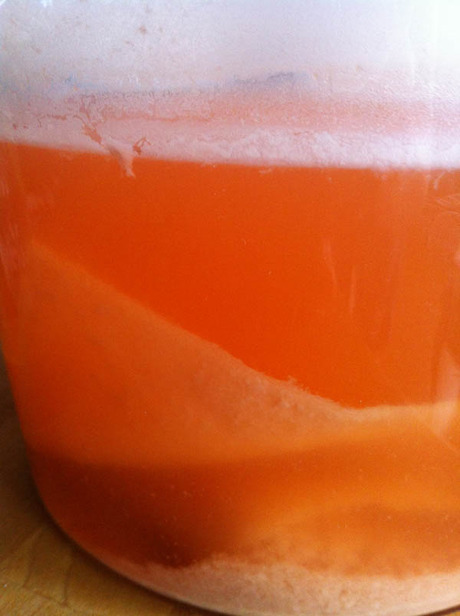Home-fermented strawberry vinegar
I’m pretty into vinegar fermentation lately since it’s such a great way to divert food waste, which I touched on briefly in this post. In fact, I’m talking about vinegar making all day with New Museum Ideas City 2013 Streetfest goers (a free, fun way to spend an afternoon in NYC) today!
No matter where you live you can still make any kind of fruit vinegar from a pile of scraps, water and a little sugar.

When using scraps for vinegar, we’re creating this distinct kitchen helper in two steps, first we need to create booze (yeasts on fruit eating the sugar water) and then we need to expose that boozy, bubbly liquid to open air so bacteria (acetobacter) can work its vinegar-making magic. The first step takes about a week, the second takes about 2-4 weeks depending on the temperature at which you’re fermenting. Vinegar loves hot apartments/kitchens (the ideal temp for acetobacter being around 80-100 degrees F) and doesn’t require much in terms of equipment. Your roommates and friends need to be on board since there’s a distinct (though not terrible) vinegar smell that starts forming as step 2 gets underway.
Stage 1: booze formation. (See recipe below) This needs to be swirled at least once a day for a week to prevent formation of mold on top of scraps.
Step 2: Strain scraps out (and compost them) and expose fruity booze to air via a cheesecloth or dishtowel cover.
This post about peach vinegar and this post about apple scrap vinegar shares the methodology along with photos of those projects as well; you can always sub whatever fruit scraps you have on hand with the exception of citrus, from which I’ve tried a few times to make vinegar and didn’t have much luck. (My advice would be to infuse existing vinegar with zest peeled in strips from the fruit with a potato peeler).
Fermented Strawberry Vinegar
STAGE 1
1. Place strawberry hulls/greens/bruised or mushy spots (anything but moldy pieces) in a wide-based glass, ceramic bowl or food-grade plastic container. Avoid metal bowls or containers.
2. Dissolve 1/4 cup sugar in 1 quart room temp water, pour over the scraps and repeat that ratio/process as many times as needed to give you one part scraps to two parts liquid. You can use honey here, but it will take longer for the fermentation to get started. The goal is to create strawberry wine (and then chuckle that you know that terrible song by the same name). In the end of the process, you’re not really drinking/eating the sugar at all thanks to the yeast on the fruit.
Cap the jar or cover the bowl with cheesecloth or a thin dishcloth. Stir the scraps daily to allow for the bubbling that will occur as the yeasts eat the sugar and to prevent surface mold from growing.
STAGE 2
3. After one week, strain the scraps from the strawberry booze and pour the liquid back into the same bowl (you can wash it in between). Add a splash of a raw vinegar, like Bragg’s Apple Cider vinegar to help get the acetobacter started (if you don’t have any on hand, then omit it entirely and everything will still work out great). Here’s where you add a vinegar mother (see following photos) if you’ve been a busy vinegar maker. Tail ends of last year’s batch of live-cultured fruit vinegar work great too!
Cover again and let sit for another two weeks—stirring every few days at first and then swirling the bowl gently as the ‘mother’ forms on the surface of the liquid.
Vinegar mothers are handy for new batches of scrap vinegar (though it’s not necessary, since the mother forms itself and reproduces herself anyway) or can be dropped into any existing wine to jumpstart a wine vinegar!
The vinegar is finished when it smells and tastes like vinegar, around the end of 2-3 weeks.
4. Pour the vinegar (and ‘mother’) into a large jar and cap tightly. If straining before bottling, set the mother in a bowl while you strain out the particles that formed over stage 2. I usually rinse the mother in room temp or cool water and drop it back in the finished jar. Store bottled vinegar at room temperature, where it will keep indefinitely. The vinegar will age nicely and develop a more complex flavor.
Here are some things you might encounter on your vinegar making path:
- Fruit flies, not the end of the world of course; I’ve noticed it happens when they’re already in the house from other things. Just don’t let them get onto the surface of your vinegar/mother.

- Filmy or odd residues in Stage 2; no cause for alarm. As the acidity increases, these filmy things lose the battle and vinegar wins. Don’t fret over them since when you do your final bottle, you can strain all this out through cheesecloth.
- Sediment-y settling. Like with above, a strain through cheesecloth before final bottling will take care of this.
 Budget Living,
Budget Living,  Fall,
Fall,  Fermentation,
Fermentation,  Food Preservation,
Food Preservation,  Food Science,
Food Science,  Fruit,
Fruit,  Green Living,
Green Living,  Healthy Living,
Healthy Living,  Recipes,
Recipes,  Reusing,
Reusing,  Spring,
Spring,  Summer
Summer 












Reader Comments (34)
Thank you so much for posting this! Bookmarking for later. I've gotten addicted to Bragg's ACV in a glass of ice water with some ginger and stevia, but dang, it's pricey!! I think this would be a tasty substitute!
Hi Kate,
all my respect fot this kind of chemistry art work! The fruit vinegar that comes out in the end looks just amazing.
Best,
Claudia
Hi, very much enjoyed your booth and our short exchange at the Ideas City festival. It allowed me to discover your blog and book. Both introduce me to new ideas and practical ways of rediscovering the joy of daily life at home.
Have a couple of questions re mother. What is it exactly? I am going to try this for the first time so do not have previous batches of vinegar, Is the Mother something that will form during the production of my first batch (is it that gooey looking film on your fingers?)
Finally when i bottle the vinegar in single 250ml bottles do i need to put in the mother too or do i strain and bottle? and in which case what do i do with the mother if i wanted to store it for when i produce my new batch.
Sorry one last question if i am making strawberry vinegar can i use the mother i recover from that to start of a peach vinegar for example? as you can see i have many questions re the mother :-)
Hey Carina, It looks like you just answered your questions re: mother over on the peach vinegar post (for anyone else with those questions, just pop over there, too!). Happy mother'ing!
Hi, could you freeze the scraps and make the vinegar later? I have some fresh berries but don't have the time to make the vinegar. Thx.
Hi Anja, yes you can freeze the scraps for a future fermentation project. Use frozen just as you would fresh scraps, no need to pre-defrost
Is this alcoholic?
Thank you
Hey Kay,
It's initially alcoholic, but as the vinegar finishes all the alcohol is pretty much consumed (by acetobacter). I've not had it professionally tested for content, but it's less alcoholic than kombucha for sure.
Enjoy your vinegar info as I enjoy making varieties with all the berry types we grow in yard. Blue berry, black,rasp,straw and new plant Indian plumb.
My hint to share is about fruit fly elimination. Take small clear glass (custard dish) you have handy. Put bits of apple or banana in dish and cover with plastic wrap then
Punch slits (5 or 6) with pointed steak knife. Make several and place where flys congregate. They can get in but not out.. When you have caught many put dish in freezer for several hours and bring out next set of dishes from freezer an cycle over again. Clean and refresh as required. They will be gone. Also rinse all beer bottles as they do like beer too and I learned that the hard way.
I am in the process of making strawberry and pineapple scrap vinegars, and I decided to omit the splash of raw vinegar in step 3. I'm approaching 4 weeks in stage 2 now, and there is still no 'mother'...just lots of sediment at the bottom. Should I just keep trucking, or will the longer fermentation hurt my vinegar?
Hey Sara Beth,
How's it smelling? If it's clearly vinegar already by smell and taste then go ahead bottle it, and if you do it with the sediment, a mother may still form. The mother isn't ultimately the sign of success, though I've found it can signal 'doneness'. If it's not quite there, which is totally normal (my last batch of strawberry vinegar was huge and took about 6 weeks to finally smell like vinegar). Longer fermentation won't hurt it, and I've found vinegar takes it's own time per the conditions under which it's fermenting. Hope this helps!
SaraBeth....if you did not innoculate with raw vinegar it can take many weeks to months for the MOV, mother of vinegar, to form. It is important to not jostle your container, as mother will form on top. Usually see an oil slick looking spot, and it extends. Acetobacter travels on the feet of fruit flies, in the wind, etc. You may want to transfer the fermented 'wine' liquid to a half gallon milk jug, cover opening with single layer cheesecloth and hang in shade of a tree for a week. Then bring inside, it should be innoculated after spending time outside, and allow to rest undisturbed for mother to form, remember it needs to be warm too. On web, do a search for Sunset Magazine, article on vinegar making, great info.
I used this recipe to make something useful out of my strawberries I let sit to long in the fridge. They were already for jam but got bubbly before I had time. I made all the batches the same but one is not a vinegar smelling as the other two. I mixed the 3 batches together and am on to finding recipes to use them for.
A tip for those who don't have cheese cloth... Use coffee filters and a rubber band.
Thanks Jen for the update and tip!
Hey Kate,
I just finished up a batch of peach vinegar and strawberry vinegar using your recipe. I'm really digging the strawberry. Question, I just found 2 12 oz containers of raspberries in fridge, some are molded and less than fresh. Could I use those to make a raspberry vinegar? Or should I pick out the obviously molded ones?
Thanks,
Anja
Hey Anja, pick out the obviously molded ones for compost, but use the syrupy, mushy ones for sure. Raspberry vinegar will be so tasty!
I have a few bottles of honey wine (mead) that are about 14% alcohol. I really don't care for the flavor as a booze, so perhaps I could turn it into vinegar. I'd like to be able to make my own vinegar for disinfecting purposes since bleach is rather unstable for long term storage (understanding vinegar may not be as effective as bleach).
Is this alcohol content at 14% too high to start a vinegar. My limited understanding of fermentation with wild yeasts, what's on your strawberries, is that it would only ferment to about 4-5% alcohol before the yeast would die.
So what do I need to do with the mead to covert it? Just set it out in an open container (with a cheese cloth cover)? If I toss in a chunk of fruit will that accelerate it? Can I jump start it with a tbsp of white vinegar bought from the grocery store, as long as it's true vinegar and not synthesized acetic acid?
I really look forward to your response! Thanks.
Tom, I'll look into it and get back with you next week when I'm back in town. Off the top of my head I'd say just set it out with cheesecloth to cover and let the acetobacter bacteria eat until there's not much alcohol left, which is approximately when you smell the vinegary ripeness and start tasting for doneness.
I cooked down and strained some apple skins/cores for jelly making but life got in the way and the liquid sat in my fridge - for 3 weeks (blush).
No sugar was added but it's pretty boozy smelling and fizzy. Could I use this for making vinegar, and if so, should I add some sugar? I only have about 3 cups liquid.
Hey Christine,
I think you should just pull it out and proceed with the process of letting it sit on the counter so the Acetobacter can just eat the booze now. No sugar needed if you already made the booze!
Let me know how it goes.
Hi, I have filled four one half gallon jars with some pineapple for making vinegar. My question is can I put a regular canning seal and lid on the jars or does it have to breathe. I just didn't want to run my family out of the kitchen with all this sitting on the counters smelling up the kitchen. Also, if it has to breathe can I use the little airlock thingies that you can get to go on top of a canning jar to release the gas out once something starts fermenting. Any suggestions would be appreciated.
During the first stage (making the fruit booze, when fruit is still in the jar) you can use a canning jar seal, being careful to burp it daily so pressure doesn't build up too much. But after you've strained out the fruit and the process of converting fruit booze into vinegar you really need oxygen and the more the better. if you're going to keep it in a jar (vs a bowl with a wider surface area) then use your canning band over a coffee filter at the very least to ensure direct air flow into the jar. The acetobacter lives on the surface and requires oxygen to convert those ethanol molecules to acetic acid (vinegar). Hope this helps Patti!
The reasons that citrus peels dont work well is because the natural oils are anti bacterial in nature. You can make citrus fruit wine with oranges, tangerines, tangelos and even lemon, but you need to remove the rind and just use the pulp and fruit, for the initial fermentation process with the yeast and sugar. Citrus wines though take a long time to age before they taste good, like 2 to 3 years. Another alternative is to make a fruit wine vinegar and then add a few drops of lemon or orange extract to taste to the final vinegar product made. That way you get that hint of citrus flavor.
Thanks Philip for the insight on that. I might try to make some citrus wine!